General
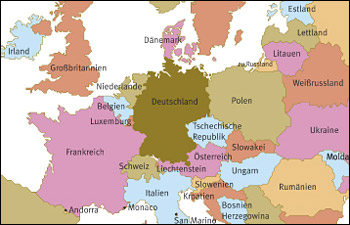
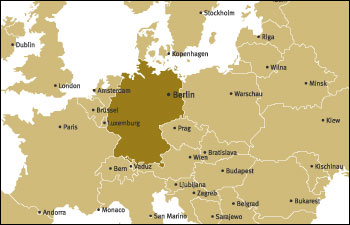

Climate

Although Germany lies, for the main part, north of the US-Canadian border and is nearer the Arctic Circle than the equator, the climate is moderate without extreme cold or hot periods. Most of Germany is situated in the moderately cool west wind zone with damp westerly winds from the North Sea. The climate in northwest and northern Germany is notably oceanic with rainfall all year round. The winters there are relatively mild and the summers comparatively cool. Eastern Germany has all the characteristics of a continental climate. There are often long cold periods in winter and the summers can be very warm. This region is also often affected by long periods of dry weather. Temperatures are at their highest in July and their lowest in January. Local differences in temperature and rainfall are commonplace. It rains more often to the west of the mountains in Germany than to the east. There are also islands of warm areas nested in the protective zones between the uplands, like the lowlands along the Upper Rhine. The lowlands of northern Germany have an average temperature of 18 degrees Celsius in July. The sunnier areas of southern Germany reach average temperatures of 19.4 degrees Celsius.
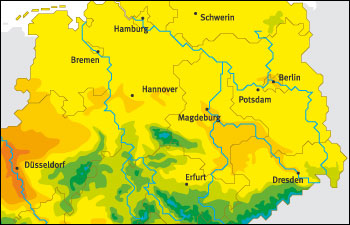
Geographic Features
The Rhine is Germany’s most famous river. One of the tourist attractions on the Rhine is the Lorelei Rock at St. Goarshausen. Legend has it that the water nymph Lorelei lured boatmen to crash against the rock with her beautiful songs. Mark Twain translated a poem from the 19th century by Heinrich Heine: "The doomed in his drifting shallop, Is tranced with the sad sweet tone, He sees not the yawing breakers, He sees but the maid alone".
Ich weiß nicht, was soll es bedeuten,
Dass ich so traurig bin;
Ein Märchen aus alten Zeiten,
Das kommt mir nicht aus dem Sinn.
Die Luft ist kühl, und es dunkelt,
Und ruhig fließt der Rhein;
Der Gipfel des Berges funkelt
Im Abendsonnenschein.
Die schönste Jungfrau sitzet
Dort oben wunderbar,
Ihr goldnes Geschmeide blitzet,
Sie kämmt ihr goldenes Haar.
Sie kämmt es mit goldenem Kamme
Und singt ein Lied dabei,
Das hat eine wundersame,
Gewaltige Melodei.
Den Schiffer im kleinen Schiffe
Ergreift es mit wildem Weh;
Er schaut nicht die Felsenriffe,
Er schaut nur hinauf in die Höh.
Ich glaube, die Wellen verschlingen
Am Ende Schiffer und Kahn;
Und das hat mit ihrem Singen
die Lorelei getan.
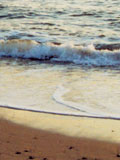
When visiting the North Sea coast the tides should be taken into account. When the tide is out only a little water can be seen. There can be a difference of many hundreds of metres during the tides. The reason is the gravitational pull between the Earth and the Moon.
Rügen is Germany’s most well known Baltic island. The chalk cliffs immortalised in the painting by Caspar David Friedrich are a tourist magnet.
The Ruhr Basin, situated in the state of North Rhine-Westphalia, is Germany’s industrial heartland. The Ruhr Basin is home to cities like Gelsenkirchen, Bochum, Oberhausen, Bottrop and Dortmund. The Ruhr Basin is also called the "Pütt" or "Kohlenpott" (coal pot) as it lived from coal and steel production until as recently as the past few decades. Today, IT, logistics and new energy sources are characteristic of the economic development in the region.
The skyscrapers in downtown Frankfurt, which lies on the River Main (abbreviation: Ffm.), form a skyline reminiscent of Manhattan, New York in the United States. This is why Germans refer to Frankfurt as "Mainhattan" – a play on words with a reference to the river Main. Frankfurt is Germany’s financial capital, the home to Germany’s banking institutions and the European Central Bank. Frankfurt is called Frankfurt am Main in Germany to differentiate it from Frankfurt an der Oder, a large town in eastern Germany on the border with Poland.
The Brocken is a mountain in the state of Saxony-Anhalt shrouded in legend. Ancient myths and fairy tales proclaim that witches meet to sing and dance on the mountain on the night of the 30th of April to the 1st of May, on what is called "Walpurgisnacht" or "Walpurga’s Eve".
The Spreewald (forest on the River Spree) is an old inland delta with a hundred-kilometre network of branching waterways. Some say that the Spreewald pickle ("Spreewaldgurke") is better known than the Spreewald. The Spreewald has a long tradition as an important vegetable growing area in Germany. The Spreewald forms part of the area settled in by Slavic Sorbs (also known as the Wends).

The Black Forest is known in German as the "Schwarzwald" and lies in the southern German state of Baden-Württemberg. It is one of the country’s most well known regions. The Black Forest is known the world over for its famous Cuckoo clocks. Every hour on the hour a door opens on the clock and an artificial bird sings out "Cuckoo".
The Alps are the largest and highest mountains in Europe. Situated in Bavaria is the Zugspitze, which at a height of 2,962 metres is the highest mountain in Germany. The Alps are home to an amazing variety of plants and animals and they are Europe’s most important water reservoir. The entire region is also a popular tourist destination.
Telling the Time
Morning: 7:50 Uhr a.m. – "Seven fifty a.m" – "Ten to eight" – 7:50
Evening: 19.50 - Neunzehn Uhr fünfzig – "Seven fifty p.m" – "Zehn vor Acht" – "Ten to eight" - 19.50 Uhr – 7:50 p.m
Summer time begins on the last Sunday in March. The clocks are put forward by one hour at 2 am in the morning to 3 am. On the last Sunday in October the clocks are put back (from 3 am to 2 am). This happens across Europe.
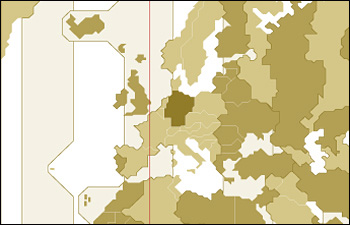
Weights and Measures
All standard weights and measures used in Germany are based on the metric system. Individual units are based on a multiple of ten.
